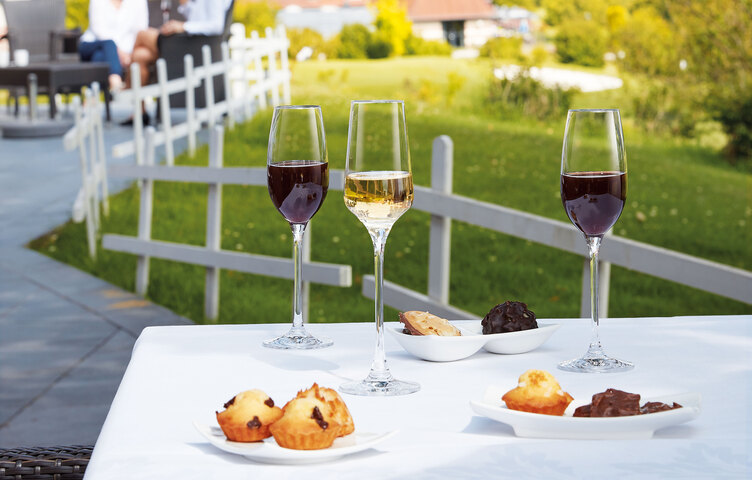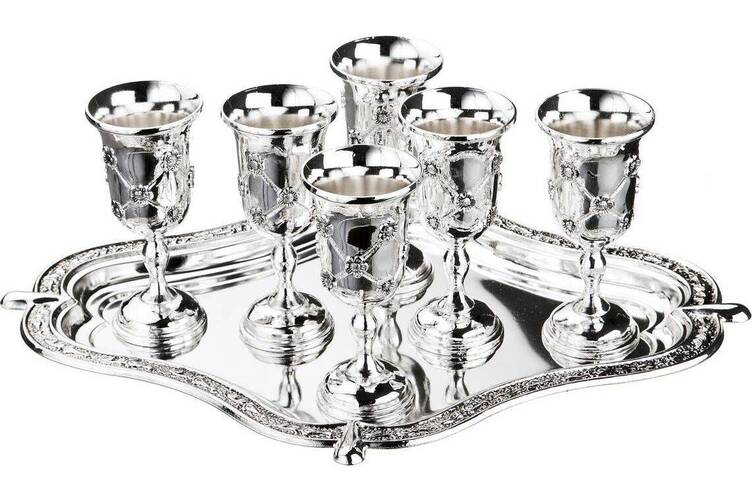It is customary to drink strong drinks in small portions. Table etiquette requires serving them in glasses - small vessels with a wide bowl and a short stem. There are more than ten varieties of this product - for vodka, cognac, liqueurs, fortified wines . The ability to navigate the glass kingdom will be useful not only for a professional bartender, but also for a hospitable host.
Types of glasses
Dishes for strong alcohol are always equipped with a deep bowl with a wide bottom. This form is necessary to speed up the evaporation of alcohol and reveal the aroma. contents The edges of the bowl may widen or narrow at the top, depending on the type of drink. The legs are usually short, with a massive base. Some types of vessels are equipped with a thickened bottom instead of legs.
There are eight main types of glasses:
- vodka;
- cognac;
- liqueur;
- madera;
- lafite;
- wine;
- cocktail;
- champagne
In terms of volume, the products are inferior to wine glasses and glasses. The maximum capacity for cognac glasses is up to 250 ml, the minimum for liqueur glasses is 25 ml.
Vodka
The standard portion of vodka in a bar is 25-30 ml. According to etiquette, only two-thirds of the glass is filled with strong drink. Therefore, the volume of vodka glasses is 50 ml . The bowl of the product resembles an inverted cone. The wide rim makes it easier for alcohol vapor to escape. The low, stable stem is convenient for drinking in one gulp. If the vodka has been cooled in advance, the stem prevents the palm from heating the bowl. Cups without a stand are called shot glasses .
Vodka glasses are made from glass , crystal , metal and even ornamental stone. But the clear drink looks most beautiful in crystal glassware.
Madernaya

Fortified wines such as sherry, Madeira, and port are usually drunk in small sips. To serve these products, special vessels are used that resemble a small copy of a white wine glass. The bowl has the shape of a tulip - convex at the bottom, slightly narrowed at the top. The benefit of a glass of Madeira or sherry is that it brings together the complex flavors of a fortified wine. With gentle shaking, the scent becomes more intense.
The shape of the product allows you to drink in small sips to enjoy the fruity notes of the wine. Fortified wines are served as an aperitif, after a meal or during dessert. Drinks are cooled to +7-14° C. The long stem prevents heating by hand.
Rainway
According to etiquette, semi-dry and dry white wines are served in vessels with a volume of 100-150 ml . The shape follows the silhouette of a universal wine glass - a bowl with a slightly widened neck, a thin rim, a high stem. Rhine wine glassware should be made of colored glass, golden green or blue. In the past, the production of dry wines was imperfect, and the product left the distillery cloudy. The colored glass hid the imperfections of the drink.
Lafite
The name of the product comes from the famous brand of French red wine Chateau Lafite. Special dishes for this variety were developed in Russia in the 19th century, when Chateau Lafite products were actively supplied to the country. At that time the vessel was called “lafitnik”. It was a glass with a bowl in the shape of an inverted cone and a short thick stem. The volume of the bowl was 50-150 ml . The main feature of the lafitnik was the ten sides on the walls of the bowl. Aristocrats preferred crystal glasses without edges, with carvings or images of the family coat of arms.
Nowadays lafitniks are made from glass, with a faceted bowl or from carved crystal. They serve sweet, semi-sweet and fortified wines, as well as vodka.
Cognac

There are two types of vessels for serving cognac - “tulip” and “drop”. The first option is distinguished by the shape of the bowl - convex at the bottom, with a smooth narrowing in the middle. The widened neck gradually releases cognac vapors, allowing you to enjoy the rich aroma. The volume of the product is 100 ml.
“Drop” holds 2-3 times less alcohol. Its bowl is cone-shaped, with a narrow bottom and a wide top. Miniature vessels are used to serve young cognacs, the aroma of which is dominated by alcohol vapor.
Liquor
Liqueur strengthin is from 15 to 45%, so they are usually consumed in small sips. Convenience of drinking is provided by a 25-45 ml glass called “cordial”. The narrow, high bowl expands upward, allowing you to enjoy the bouquet of the drink. The stem of the product is usually shorter than the bowl. Glassware for liqueurs is made of thin colored glass or crystal; transparent materials are used less frequently.
Cocktail room
As the name suggests, the vessel is used to serve cocktails. The main distinguishing feature is a wide bowl in the shape of a triangle. These glasses are also called “martini glasses”, as they are most often used to serve martinis. The glassware is suitable for various cocktails that are mixed using the “shake” method – Manhattan, Gimlet, Cosmopolitan. Different versions of martinki hold a glass with a volume of 25-45 ml . They do not serve undiluted alcohol.
For champagne

Usually sparkling wines are served in glasses with a capacity of 170-200 ml . There is a type of vessel called a glass that can hold up to 150 ml. The shape of the product follows the silhouette of a flute glass - a narrow cylindrical bowl on a high stem. Champagne bubbles beautifully in such a container, gradually revealing its bouquet. Sparkling wines are served in small glasses in hot weather so that the small volume of the drink does not have time to warm up.
Materials
The glass is one of the “youngest” vessels for serving alcohol in history. It appeared with the invention of crystal in the 17th century. At first, small glasses were used only for sparkling wines; later, glassware for cognac and liqueurs appeared. Crystal was the privilege of aristocrats; glass and metal wine glasses were produced for ordinary people. Now in stores you can find products made from various types of crystal and glass, stainless steel, bronze and even semi-precious stones.
Glass
This material is most popular in catering establishments and household use. Glassware is inexpensive, looks impressive, and is easy to clean. Stores offer a variety of models of wine glasses - made of transparent and colored glass, with gilding, relief patterns, and engraving. Tempered and borosilicate glass is highly durable.
But glass products require careful handling and careful maintenance. Immediately after use, the glasses should be washed and dried thoroughly so that no stains remain on the walls.
Classic crystal
This is the name given to a material that contains up to 40% lead. Products made from it sparkle beautifully, especially if the walls are decorated with carvings. The structure of the crystal accelerates the saturation of the wine with oxygen, due to which the taste of the drink is fully revealed. Crystal glasses are much stronger than glass, and with careful handling they can last for decades.
Dishes made from classic crystal require careful care - hand washing with cold water, regular rinsing with lemon juice. For storage, glasses are placed on a separate shelf or in a drawer so that the objects do not touch each other.
Crystal glass
Historically, crystal glass was characterized by lead oxide content ranging from 13-23% and potassium oxide content of approximately 17%. Traditional Venetian and Czech products were classified as crystal, despite changes in composition.
Their patented Tritan™ material is carefully processed, including hardening in contrast water baths, cooling and precision grinding. The cuts are made with a laser to ensure perfectly smooth and thin edges. This process makes the glass durable, transparent and aesthetically pleasing, while maintaining the refraction of light characteristic of real crystal. By strengthening vulnerable areas, the products are surprisingly durable and dishwasher safe.
Thus, modern crystal glass not only retains its elegant appearance, but is also highly durable without posing a health hazard. These characteristics make it an ideal choice for establishments that require stylish and practical tableware.
Metal

A variety of metals and metal alloys are used to make shot glasses, including:
- stainless steel;
- brass;
- bronze;
- tin;
- cupronickel;
- silver.
Metal liquor utensils are often used as men's gifts. Shiny cups decorated with casting or engraving look impressive and last a long time. Metal shot glasses are durable and non-corrosive, making them suitable for a feastOutdoors. Usually they contain strong clear alcohol - vodka, gin, soju.
Plastic
Cups made of durable plastic are used in inexpensive catering establishments, as well as during fishing trips and picnics. Plastic utensils do not break, do not require careful transportation, and weigh little. The choice of models is varied - transparent, matte, colored, with patterns and gilding. If you don’t want to wash the dishes after a feast, you can purchase a disposable set.
Plastic glasses are often used as part of Sanpin in establishments where there is contact with water, for example: Pool bars, hotels in the pool area.
Recommendations for selection
First of all, determine what type of vessels you need - for vodka, wine or liqueurs. If you already have a collection of vodka shot glasses at home, it is better to purchase a set of “tulips” or sherry glasses.
Consider three more factors:
volume - depends on the type of drinks you usually serve to guests. For cognac and vodka, glasses with a capacity of 50-100 ml are suitable, for wine - from 100 ml.
style - choose vessels that match the look of your dinner set. Clear tempered glass and crystal with a simple design fits any style.
It is recommended to have at least two sets of glasses at home - for strong alcohol and wine. The set must contain from 6 to 12 items.
How to care for glasses
Glassware for alcoholic beverages is used on special occasions, so it has an elegant design and a high price. To keep your products looking great for as long as possible, wash them immediately after use. All types of crystal and glass are washed with cold water. Household chemicals are undesirable; for perfect cleanliness and shine, rinse the glasses with an aqueous solution of vinegar, lemon juice or baking soda. Wipe the washed wine glasses dry with a towel and dry them by placing them on the table.
Metal shot glasses can be washed with soap. From time to time they need to be cleaned with special products for metals.
















































/https%3A%2F%2Fcomplexbar.com%2Fimages%2Fblog%2F245%2Fpymki.jpg)
/https%3A%2F%2Fcomplexbar.com%2Fimages%2Fblog%2F245%2Fskov_glavn.jpeg)
/https%3A%2F%2Fcomplexbar.com%2Fimages%2Fblog%2F245%2Fhaiboli.jpg)
/https%3A%2F%2Fcomplexbar.com%2Fimages%2Fblog%2F245%2Fvilki-na-stole-752x480.jpeg)
/https%3A%2F%2Fcomplexbar.com%2Fimages%2Fblog%2F246%2F2024-04-09_17.22.54.jpg)
/https%3A%2F%2Fcomplexbar.com%2Fimages%2Fblog%2F246%2F2024-04-09_17.22.47.jpg)
/https%3A%2F%2Fcomplexbar.com%2Fimages%2Fblog%2F246%2FCODE_anons_foamydrops_752%D1%85480_eng.jpg)
/https%3A%2F%2Fcomplexbar.com%2Fimages%2Fblog%2F246%2FAlina_752%D1%85480_eng.jpg)
/https%3A%2F%2Fcomplexbar.com%2Fimages%2Fblog%2F246%2F2024-04-09_17.23.22.jpg)
/https%3A%2F%2Fcomplexbar.com%2Fimages%2Fblog%2F246%2F2024-04-09_17.23.28.jpg)
/https%3A%2F%2Fcomplexbar.com%2Fimages%2Fblog%2F246%2F2024-04-09_17.23.35.jpg)
/https%3A%2F%2Fcomplexbar.com%2Fimages%2Fblog%2F246%2Fdrinksome_752%D1%85480_eng.jpg)
/https%3A%2F%2Fcomplexbar.com%2Fimages%2Fblog%2F246%2Fnude_752%D1%85480_eng.jpg)
/https%3A%2F%2Fcomplexbar.com%2Fimages%2Fblog%2F246%2F752%D1%85480_eng__1_.jpg)
/https%3A%2F%2Fcomplexbar.com%2Fimages%2Fblog%2F246%2F752%D1%85480_eng.jpg)
/https%3A%2F%2Fcomplexbar.com%2Fimages%2Fblog%2F246%2FStudioRaw_752%D1%85480_eng.jpg)
/https%3A%2F%2Fcomplexbar.com%2Fimages%2Fblog%2F246%2FDoppio_tea_752%D1%85480_eng.jpg)
/https%3A%2F%2Fcomplexbar.com%2Fimages%2Fblog%2F246%2FTognana_Stars_Stripes_752%D1%85480_eng.jpg)
/https%3A%2F%2Fcomplexbar.com%2Fimages%2Fblog%2F246%2FRona_752%D1%85480_eng.jpg)
/https%3A%2F%2Fcomplexbar.com%2Fimages%2Fblog%2F246%2FDoppio_vending_752%D1%85480_eng.jpg)
/https%3A%2F%2Fcomplexbar.com%2Fimages%2Fblog%2F246%2FEssence_sukhie_smesi_752%D1%85480_eng.jpg)
/https%3A%2F%2Fcomplexbar.com%2Fimages%2Fblog%2F246%2FODK_sukhie_smesi752%D1%85480_eng.jpg)
/https%3A%2F%2Fcomplexbar.com%2Fimages%2Fblog%2F246%2Funiforma-barmena.jpg)
/https%3A%2F%2Fcomplexbar.com%2Fimages%2Fblog%2F246%2Fkak-nanyat-barmena.jpg)
/https%3A%2F%2Fcomplexbar.com%2Fimages%2Fblog%2F246%2Fsirop_scale_2400.jpeg)
/https%3A%2F%2Fcomplexbar.com%2Fimages%2Fblog%2F246%2FPeugeot_Anons_Paris_U%27Select_Line_Daman_752%D1%85480_eng.jpg)
/https%3A%2F%2Fcomplexbar.com%2Fimages%2Fblog%2F246%2Fkofe-vostochniy.jpg)
/https%3A%2F%2Fcomplexbar.com%2Fimages%2Fblog%2F246%2FMadler.jpg)
/https%3A%2F%2Fcomplexbar.com%2Fimages%2Fblog%2F246%2Fprofbartender_glavn.jpeg)